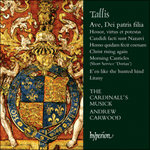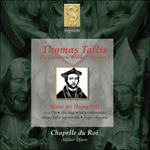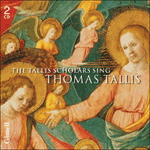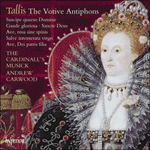
Welcome to Hyperion Records, a British classical label devoted to presenting high-quality recordings of music of all styles and from all periods from the twelfth century to the twenty-first.
Hyperion offers both CDs, and downloads in a number of formats. The site is also available in several languages.
Please use the dropdown buttons to set your preferred options, or use the checkbox to accept the defaults.

The text has seven stanzas, of which the last is extended, the number seven often having been associated with the Virgin, most obviously in the Feasts of the Seven Joys and Seven Sorrows. Each stanza begins with the word ‘Ave’, and each begins a new section in the music, which mostly involves a change in scoring. To create a strong half-way point Tallis joins stanzas three and four into a long full section; and he is able to do the same at the end with the extended seventh stanza, building its ‘Amen’ into something magnificent. In between are some substantial trios and one duet (stanza six). Twice the initial ‘Ave’ is given special emphasis by the marking of fermatas (or pauses) over each of its syllables.
Though all of Tallis’s antiphons are fairly early works, Ave, Dei patris filia gives the impression of being one of his first mature compositions (contemporary with the Magnificat and earlier than Audivi vocem and Puer natus est nobis), probably written in the 1530s. It shows signs of being an apprentice work in the closeness with which it follows the layout and detail of Fayrfax’s setting of the same text, especially at the beginning, at ‘Ave, Eterne’, and largely in the overall scoring. In fact, as Dr Skinner has shown, it was possible to identify where the missing tenor part sounded in the Tallis from a close study of Fayrfax’s own scoring.
Ave, Dei patris filia also shows the strong influence of John Taverner’s music, though in fact Tallis amalgamated two contrasted, though not contemporaneous, elements in Taverner’s style. On the one hand he chose to write a full-length festal votive antiphon while, like Taverner, avoiding the kind of purely virtuosic display in the vocal lines which is more often found in similar works by Cornysh and Browne; on the other he regularly deployed one of Taverner’s favourite techniques from his later and more compact non-festal antiphons – creating answering phrases in the full sections between the two top voices and the three lower ones with almost syllabic word setting. Somehow, by working quite brief motifs on a festal scale, Tallis was able to conceive some of the most memorable writing in all his pre-Reformation compositions – ‘semper virgo Maria’ just before the ‘Amen’ is a perfect case in point. There is nothing flamboyant about this, and yet this music seems to have all the time and spaciousness associated with the old festal antiphon, and the late medieval world which promoted it.
from notes by Peter Phillips © 1998
Le texte compte sept strophes – la dernière est prolongée –, le chiffre sept ayant été souvent associé à la Vierge, notamment dans les fêtes des Sept joies et des Sept douleurs. Chaque strophe s’ouvre sur le mot «Ave» et inaugure une nouvelle section musicale impliquant, la plupart du temps, un changement de distribution vocale. Pour mieux accuser le milieu de l’oeuvre, Tallis réunit les strophes trois et quatre en une longue et pleine section – ce qu’il parvient à refaire, à la fin, avec la septième strophe prolongée, lorsqu’il intègre son «Amen» à un édifice magnifique. Entre ces deux moments s’intercalent de substantiels trios et un duo (strophe six). Par deux fois, l’«Ave» initial se voit conférer une emphase particulière grâce à des fermata (points d’orgue) placés au-dessus de chacune de ses syllabes.
Bien que les antiennes vocales ressortissent plutôt aux oeuvres de jeunesse de Tallis, Ave, Dei patris filia donne l’impression d’être l’une des premières pièces de la maturité du compositeur (contemporaine du Magnificat, elle est antérieure à Audivi vocem et à Puer natus est nobis). Probablement écrite vers 1530, elle rentre dans les années d’apprentissage du compositeur, en ce qu’elle suit étroitement la disposition, le détail, mais aussi l’écriture de l’Ave, Dei patris filia de Fayrfax, surtout au début (à «Ave, Eterne»). Comme l’a montré le Dr. Skinner, l’on put même identifier l’emplacement de la partie de ténor manquante chez Tallis en étudiant de près la distribution vocale de la pièce de Fayrfax.
Ave, Dei patris filia dévoile également une forte influence de la musique de John Taverner, même si, en réalité, Tallis amalgama deux éléments contrastés (quoique non contemporains) du style de ce compositeur. D’une part, il choisit d’écrire une longue antienne votive de fête, tout en évitant, comme Taverner, le genre de déploiement virtuose, dans les lignes vocales, que l’on rencontre plus volontiers dans des pièces similaires de Cornysh et de Browne; d’autre part, il recourut régulièrement à l’une des techniques favorites des antiennes ordinaires, plus tardives et compactes, de Taverner – créant des phrases qui se répondent, dans les sections où toutes les voix sont distribuées, entre les deux voix supérieures et les trois voix inférieures, avec une mise en musique quasi syllabique. En travaillant de très brefs motifs, sur une gamme festive, Tallis parvint à concevoir certaines des pages les plus mémorable de toutes ses compositions d’avant la Réforme – «semper virgo Maria», juste avant l’«Amen», en est la parfaite illustration. Rien n’y est flamboyant, et pourtant cette musique semble disposer de tout le temps, de toute la spaciosité liés aux vieilles antiennes de fête et à l’univers médiéval tardif qui en fut le promoteur.
extrait des notes rédigées par Peter Phillips © 1998
Français: Gimell
Der Text umfaßt sieben Strophen, von denen die letzte erweitert ist, denn die Zahl Sieben wurde häufig mit der Jungfrau Maria in Verbindung gebracht, am offensichtlichsten im Zusammenhang mit den „Festen der sieben Freuden und der sieben Schmerzen“ (Compassio Marie). Jede Strophe beginnt mit dem Wort „Ave“ und eröffnet zugleich einen neuen musikalischen Abschnitt, was meist auch mit einer Änderung des Stimmsatzes einhergeht. Um den Mittelpunkt besonders deutlich zu markieren, hat Tallis die dritte und vierte Strophe zu einem einzigen voll besetzten Abschnitt zusammengefaßt, eine Technik, die er auch am Ende bei der erweiterten siebten Strophe anwendet, wodurch das „Amen“ besonders erhaben wirkt. In den übrigen Strophen finden sich einige gehaltvolle Trios und ein Duett (sechste Strophe), und zweimal wird das anfängliche „Ave“ durch Fermaten (oder Pausen) über jeder Silbe besonders betont.
Obschon alle Antiphone von Tallis recht frühe Werke sind, hinterläßt Ave, Dei patris filia doch den Eindruck, eine der ersten reiferen Kompositionen zu sein (etwa zeitgleich mit dem Magnificat und früher als Audivi vocem und Puer natus est nobis), entstanden wohl in den 1530er Jahren. Die Nähe, mit der es in der äußeren Anlage wie auch in manchem Detail Fayrfax’ Vertonung des gleichen Textes folgt, läßt darauf schließen, daß es sich um ein Frühwerk handelt, namentlich zu Beginn bei „Ave, Eterne“, und überhaupt legt dies auch die gesamte Satztechnik nahe. Wie Dr. Skinner gezeigt hat, war es so tatsächlich möglich, anhand einer genauen Untersuchung des Fayrfax-Satzes zu entscheiden, wo der fehlende Tenorpart im Satz Tallis’ erklungen sein muß.
Auch Ave, Dei patris filia weist starke Bezüge zur Musik John Taverners auf, selbst wenn Tallis zwei gegensätzliche, doch nicht zeitgleich auftretende Elemente von Taverners Stil miteinander verschmolzen hat. Einerseits hat er sich dafür entschieden, eine festliche Votivantiphon in voller Länge zu schreiben, wobei er – wie Taverner – jene Art des rein virtuosen Blendwerks der Gesangslinien vermeidet, wie man sie in ähnlichen Werken etwa bei Cornysh und Browne findet. Andererseits wendet er eine von Taverners Techniken an, die dieser in seinen späteren, kompakteren Antiphonen für nicht-festliche Anlässe bevorzugte, und schafft in den vollstimmigen Abschnitten antwortende Phrasen zwischen den beiden Ober- und den drei Unterstimmen, wobei der Text beinahe syllabisch behandelt wird. Und so stellt Ave, Dei patris filia mit der Ausarbeitung der eigentlich recht kurzen Motive zu einem festlichen Rahmen eine der denkwürdigsten Kompositionen Tallis’ aus der Zeit vor der Reformation dar – wofür sich gerade „semper virgo Maria“ genau vor dem „Amen“ als ein wunderbares Beispiel nennen läßt. Nichts Überladenes haftet dem Werk an, und doch verfügt die Musik ganz über jenen Umfang und jene Weitläufigkeit, die man mit der alten Festantiphon verbindet, und die das späte Mittelalter so begünstigt hat.
aus dem Begleittext von Peter Phillips © 1998
Deutsch: Matthias Lehmann
 Tallis: Ave, Dei patris filia & other sacred music Tallis: Ave, Dei patris filia & other sacred musicThe Cardinall’s Musick continues our Tallis series with an opulent Votive Antiphon and music written for the early Anglican church.» More |
 Tallis: The Complete Works, Vol. 1 Tallis: The Complete Works, Vol. 1This debut album recorded by Chapel du Roi is the first in a series of nine covering the complete works of Thomas Tallis (c1505-1585). Not for nothing is Tallis known as the 'father of church music'—with his colleagues at the Chapel Royal he creat ...» More |
 Tallis: The Tallis Scholars sing Thomas Tallis Tallis: The Tallis Scholars sing Thomas TallisIncluding Spem in alium as featured in 'Fifty Shades of Grey'. The author, E L James, said: 'I am delighted to have introduced so many of my readers to this amazing 16th-century piece of music, it is absolutely wonderful and the recording from The ...» More |
 Tallis: The Votive Antiphons Tallis: The Votive AntiphonsHighlights from Hyperion’s series of Tallis recordings by Andrew Carwood and The Cardinall’s Musick.» More |

